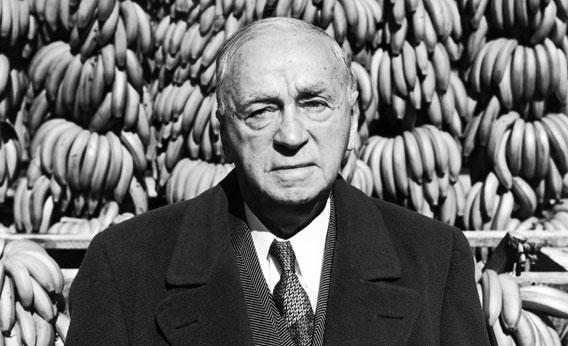The Fish that Ate
the Whale: The Life and Times of America’s Banana King

In
1910, Sam “the Banana Man” Zemurray, head of Cuyamel Fruit Company,
orchestrated a coup against the government of Honduran president Miguel Dávila.
Zemurray provided guns, money, and a former US naval warship to former
president Manuel Bonilla. The Cuyamel Fruit Company owned plantations in
Honduras and shipped bananas to the United States on its own fleet of ships. Success
in the volatile banana business relied on bribes and kickbacks to the Honduran
government, keeping the cost of business low and the profit margins high. When
the United States agreed to a treaty with President Dávila to administer
Honduras’s staggering national debt, Zemurray’s business was in danger. With
the J.P. Morgan Company’s agents assigned to Honduran customs houses collecting
taxes on Cuyamel exports, Zemurray would be taxed out of business. Secretary of
State Philander Knox warned Zemurray not to interfere in Honduras, but Zemurray
proceeded with the coup anyway. When Bonilla came to power, he voided the deal
with the U.S., protected Zemurray’s interests, and allowed Honduras’s crippling
debt to continually plague the nation.
 |
| The house that Bananas built--it now belongs to Tulane. |
Richard
Cohen begins his lively biography of Zemurray with this anecdote highlighting
the extent that Zemurray, an immigrant from present day Moldavia, would go to
protect his business and his own interests. Cohen emphasizes how Zemurray’s
meteoric rise from impoverished immigrant to the “Banana Man” embodies the
equally inspiring and dispiriting nature of the American dream. Zemurray began
his career by seizing upon the untapped potential in the banana market: ripe
bananas. In the last quarter of the 19th century, importers
discarded ripe bananas because they would turn bad before they could reach
distant markets. Zemurray bought up the ripe bananas, arranged a delivery deal
with a local railroad, and made a fortune. Zemurray soon bought banana
plantations, banana boats, and anything and everything related to the
production of bananas. Making himself into a banana mogul required payoffs to
local governments, buying land from natives on the cheap, and other morally
ambiguous behaviors endemic to capitalistic enterprise In 1930, Zemurray sold
Cuyamel to United Fruit Company. Several years later, Zemurray orchestrated
another coup, this time to seize control of United Fruit. He saved it from the
disastrous management that nearly ruined the company during the Great Depression.
Zemurray succeeded in turning United Fruit around. In 1961, Zemurray died a
rich man with a troubled legacy.
 |
| Sam the Banana Man |
Cohen’s
book has two great strengths. The first is the fascinating life story of
Zemurray with his impoverished roots, his rise, and his moral compromises
necessary to stay on top, and his later in life devotion to philanthropy.
Second, Cohen’s energetic and sarcastic prose makes for an enjoyable read. The
first sentence of the book sets the tone for the rest, “Sam Zemurray spoke with
no accent, except when he swore, which was all the time” (3). At 242 pages,
with some padding*, the book reads quickly. I finished it in a few hours of
reading. Cohen also offers his own thoughts and insights into Zemurray’s life,
recalling his own efforts to grow a banana in Connecticut, his attempts to imagine
and understand the banana plantations of Central America, and a hilarious
footnote about a New Orleans policeman refusing to take Cohen into the
Iberville Projects, “’cause the sun is going down and I love my kids” (245). He
also enlightens the reader on the emergence of the banana into the American
marketplace in the late 19th century and how the foreign fruit
(Cohen argues that the banana is in fact a berry) became a quintessential
staple of the American diet. He also provides insight into the different types
of bananas and their unique features. In any specific type of banana, all of
the bananas are clones of each other—making them uniform but also susceptible
to disease. Zemurray made his fortune
importing the Big Mike banana, a type that died out in the 1960s. Today’s
bananas are of the Cavendish variety and those will soon go extinct as well.
The book takes a few diversions into the history of United Fruit’s activities
in the 1950s and Zemurray fades into the background. This shift of focus leaves
the responsibility that Zemurray had for the CIA’s or United Fruit’s activities
in Central America in the 1950s unclear. He also makes several factual errors
about the early history of the CIA that I was only aware of because I just read
a biography of the founder of the Office of Strategic Services.**
Overall
Cohen’s book succeeds as an entertaining and educating sread.
*most
notably skipping a whole page before starting a new chapter
** He
incorrectly states that the OSS was not dissolved at the end of World War II.
It was. The CIA was not created until 1947. Secondly he identifies Walter
Bedell “Beetle” Smith and Allen Dulles as the 1st and 2nd
Directors of Central Intelligence, they were the 4th and 5th.

No comments:
Post a Comment